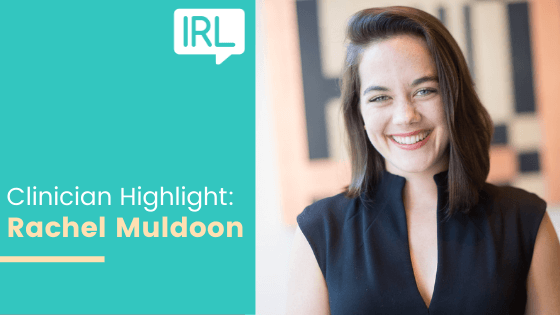You may know her as your speech therapist or the instructor of our Mindful Communication course, but there’s probably a lot more that you don’t know about our Director of speech IRL West, Rachel Muldoon MSc, CCC-SLP. Rachel has been a practicing speech language pathologist for 5 years, plus 6 years of study. She is a certified yoga instructor, which informs her therapy with deeper physical awareness and experience with meditation. Rachel relocated from Chicago to California in the summer of 2020, where she founded our first expansion office, speech IRL West! Read on for more about Rachel’s specialty areas, her career in SLP and a few more surprises.
Rachel’s Areas of Expertise
Though she has worked with clients on a wide range of speech goals, Rachel is especially passionate about helping high functioning people with executive functioning issues such as ADHD. In practice, this kind of therapy includes exercises and activities that build skills around planning, organization, time management and attention. Language disorders are another area where she really excels. These individuals have trouble creating thought with words and understanding messages via language.
Rachel also helps clients with social anxiety and social communication difficulties, or trouble relating to others and knowing how to build relationships, and clients who stutter. Rounding out her robust skillset, Rachel works with business communication clients who don’t have a disorder but want to learn how to better manage their team, communicate more effectively, or work with a difficult boss. In addition to individual therapy, she provides services through group therapy, individual coaching, team coaching and workshops.
A Day in the Clinic: Speech Therapy Stories
What keeps Rachel inspired and motivated? In response to this question, Rachel says, “I’m inspired daily by my clients’ bravery. It has changed me in a personal way as well as a professional way.” She adds that seeing clients week to week and hearing that they have successfully used the tools they discussed in therapy to face a previous or current fear is particularly rewarding.
Rachel shared an example story of a client who had a rare combination of ADHD and expressive language issues. While she loves figuring out how her clients perceive their communication issues and solving the puzzle of which treatments will help them most effectively, this was a big challenge. She decided to approach this client’s therapy from an ADHD standpoint to understand how he was organizing his thoughts and then apply these executive function insights to understanding and expressing language. This approach worked, and the client was finally able to see growth and progress with his communication.
On the professional side, Rachel recalled an example of a client who struggled with "reading people" and was struggling with hostile dynamics in the workplace. It was crucial to tease out areas for individual improvement, and what was more environmentally-driven. Rachel started by reviewing scenarios and possible interpretations with the client. A couple of weeks later, the client came back and happily reported that she confronted the one coworker with whom there was significant tension. They had a heart-to-heart conversation in which he shared that he also had some trouble connecting with others, and this was not the first time someone had perceived his tone to be more aggressive than he meant it to be. This was an eye-opening moment of realization for Rachel’s client: she saw firsthand that perceptions aren’t always the truth. And she was relieved to know that her work environment wasn’t as hostile as she originally thought.
Rachel IRL
Rachel first got into speech-language pathology because she had a hunch that it would be a good career path for her—once she started practicing with real clients, it was obvious that she had made the right choice. But four years of studying was a big commitment! Rachel notes that the experience of learning about speech-language pathology is much different than working with clients, and nowhere near as fulfilling. “When you see it in person, it puts a face to the disorder and the percentage and to the therapy,” Rachel said. It makes sense that one of her favorite activities to do with clients (when we’re not on quarantine) is visiting grocery stores and coffee shops to interact with cashiers and talk about it afterward. Or, as we like to call it, speech IRL.
Rachel’s work with clients is driven by her values of communication, connection and empowerment. She is inspired by the power of language to change behaviors and create more possibilities. Personally connecting with others and helping them overcome their language and communication difficulties is a personal mission of Rachel’s, and she practices kindness and mindfulness both as an individual and as a professional, always listening with an empathetic ear.
Outside her work at the clinic, Rachel has been raising her 2 year old son and continuing to advance her mastery of Spanish. As a certified bilingual Spanish-English SLP, Rachel integrates her personal experience of learning languages and her empathy for those who have trouble communicating. One thing she wishes more people knew about speech-language pathology is that a disorder or communication difference doesn’t have to be the sole problem of the person it belongs to; they can work together with the people around them to find solutions as a group. In Rachel’s words, “If we can develop our own empathy for other people’s issues, it will be easier for all parties involved.”

